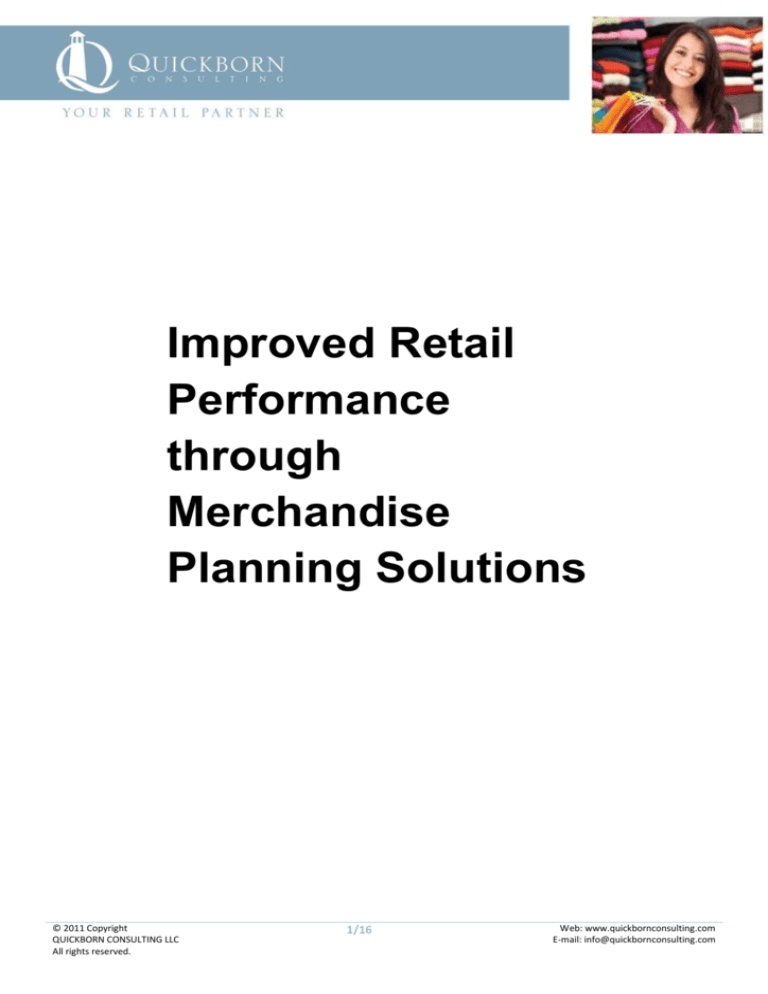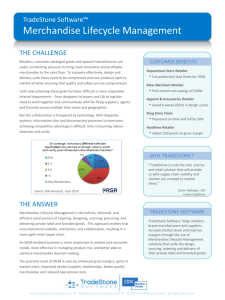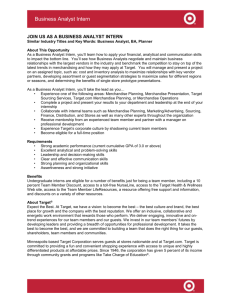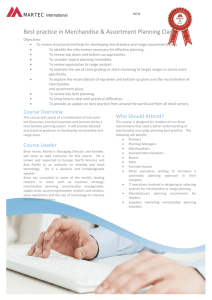
Improved Retail
Performance
through
Merchandise
Planning Solutions
© 2011 Copyright
QUICKBORN CONSULTING LLC
All rights reserved.
1/16
Web: www.quickbornconsulting.com
E-mail: info@quickbornconsulting.com
EXECUTIVE SUMMARY
The Demand to meet changing business needs is greater than ever; retailers are
continually required to adapt, innovate and react. Increased competition, commodity
price volatility, evolving consumer preferences and a multitude of channels to interact
with customers are forcing retailers to think and execute new business strategies for
growth and profitability. Putting in place the right business processes and deploying
the right technology solutions can help retailers to improve their bottom-line.
Retail is a data-intensive industry, and to take advantage of the abundant data, to operate
and to manage the business better requires analytics. In order to satisfy the needs of the
customers and to be profitable, having the right product at the right place at the right time
and in the right amount is crucial. The capacity to measure consumer needs and the ability to
understand the buying process, along with the awareness of products sales across channels
and stores is necessary.
Merchandise planning is an incessant struggle to balance the trends of the merchandise and
stores while meeting the financial objectives of the company in efforts to maximize profits
and drive improvements. The process of merchandise planning enhances the possibility of
increased stock turns, thus capacitating higher sales with lower capital investments. By
creating an effective merchandise plan retail companies can find the optimal balance
between sales and inventory; maximizing sales opportunities and minimizing losses from
excessive mark downs and out of stocks.
In most cases, poor merchandise decisions lead to lower revenue and gross-margins, lower
sell-thru and high levels of inventory at low service levels. Merchandising software reduces –
or in the best case eliminates – guesswork, helping retailers to plan and execute
merchandise operations, including deciding which items to stock, where to stock them, when
to promote them, and how to price them by utilizing sophisticated mathematical models and
optimization routines to create intelligent estimates of future business opportunities.
Analytical tools help retailers see the impact of their decisions to better plan future
merchandising strategies.
This white paper aims at illustrating:
How merchandise planning solutions can help retail organizations to make
better decisions faster delivering major financial benefits
What types of retail merchandise planning solutions are available and how to
choose the optimal solution
What are the business, functional and technical prerequisites of implementing
retail merchandise planning software
How to guarantee the merchandise planning software implementation success
and how to select the optimal integrator partner
© 2011 Copyright
QUICKBORN CONSULTING LLC
All rights reserved.
2/16
Web: www.quickbornconsulting.com
E-mail: info@quickbornconsulting.com
TABLE OF CONTENTS
EXECUTIVE SUMMARY ...................................................................................................................... 2
TABLE OF CONTENTS ....................................................................................................................... 3
1. INTRODUCTION TO MERCHANDISE PLANNING ....................................................................... 4
2. MERCHANDISE PLANNING SOFTWARE SOLUTIONS ............................................................. 8
Why to implement Merchandise Planning Software? ............................................................................ 8
What are the benefits? ........................................................................................................................... 9
How to chose the optimal solution? ..................................................................................................... 10
3. PREREQUISITES OF IMPLEMENTING MERCHANDISE PLANNING SOFTWARE ...............11
4. CHOOSING THE RIGHT IMPLEMENTATION PARTNER ..........................................................12
5. WHY TO PARTNER WITH QUICKBORN CONSULTING ...........................................................13
© 2011 Copyright
QUICKBORN CONSULTING LLC
All rights reserved.
3/16
Web: www.quickbornconsulting.com
E-mail: info@quickbornconsulting.com
1. Introduction to Merchandise Planning
Retail is a data-intensive industry, and to develop or transform retail supply chains so
that they realize their full potential requires analytics. Analytics has become one of the
most powerful tools available to retailers, and is being used for a broad variety of
purposes. One of these is the merchandising planning operations, on which this
whitepaper focuses on.
Merchandising is one of the most integral and challenging functions within the retail
company. Retail merchandising consists of the planning, buying and selling of
merchandise. In order to satisfy the needs of the customers, having the right product mix
at the right place at the right time and in the right amount is crucial for the retailer in
order to maximize profitability. To enable this retailers need to optimize each of these
aspects. The merchandise assortment that the retailer has on offer in the store plays a
crucial role in determining whether the purchase will or will not be made by the customer.
Planning is required since the merchandise to be sold in the future must be bought in
advance.
Merchandise planning can be defined as the process of setting and maintaining future
performance objectives for sales, inventory and other financial metrics and tracking
actual results and variances in the achievement of these objectives. Planning decisions
are based on historical trends and management insight into expected future demand
changes.
Analysis is the starting point of merchandise planning; the retailer’s business model
naturally being the strategic starting point of the analysis. An understanding of the
consumer needs, behavioural patterns across seasons/regions and buying process is
necessary as well as which products are actually selling and where. This requires
analysis of past sales and changes in the market environment and consumer trends.
Merchandise planning is a struggle to balance the trends of the merchandise and stores
while meeting the financial objectives of the company in efforts to maximize profits and
drive improvements.
Merchandise planning benefits the retailer as it enhances the possibility of having the
right assortment of goods with the adequate amount of depth available at the stores
where it is needed. The process of merchandise planning enhances the possibility of
increased inventory turnover, thus releasing important working capital. By creating an
effective merchandise plan retail companies can find the optimal balance between sales
and inventory; maximizing sales opportunities and minimizing losses from excessive
mark downs and out of stocks.
© 2011 Copyright
QUICKBORN CONSULTING LLC
All rights reserved.
4/16
Web: www.quickbornconsulting.com
E-mail: info@quickbornconsulting.com
Two main steps enable a retailer to optimize its merchandise planning process:
•
•
Step 1: Developing a sales forecast and thus determining the inventory needs of
the product or category. Forecasting will answer questions such as which
products should be purchased and what price should be charged. Forecasting
components include past demand, lead time involved in the product supply,
merchandise trends and market environment impact (consumers, competitors,
suppliers, …)
Step 2: Determining the merchandise requirement, including the creation of the
merchandise budget and the assortment plan, either top down or bottom up. The
merchandise budget is a financial plan indicating how much to invest in product
inventories.
The overall merchandising strategy involves:
•
•
•
•
Establishing performance goals and budget
Deciding on the basis of demand trends which merchandise should be given
emphasis
Analyzing historical performance of each product category. Establishing sales
forecast and inventory requirements
Allocating assortments for the coming season merchandise categories
© 2011 Copyright
QUICKBORN CONSULTING LLC
All rights reserved.
5/16
Web: www.quickbornconsulting.com
E-mail: info@quickbornconsulting.com
There are many factors that affect the merchandise planning function, such as the size
and structure of the organization, the type of stores, the type of merchandise sold and
the demography of the region in which the retailer operates.
The type of merchandise sold completely changes the way of how the merchandise
planning is executed. For the purpose of planning the merchandise is split into
categories. The categories are managed by purchasers and merchandise planners, as
well as vendors. When forecasting sales, retailers should identify the stage of the
lifecycle of the specific category, and should also determine whether the merchandise
category offered is a basic item (staple), a fashion item (fad fashion, classic fashion) or a
seasonal item, and to plan merchandising accordingly.
Staple merchandise, also called basic merchandise, is in continuous demand over an
extended period. This includes most merchandise in grocery stores, such as milk, bread
or canned soup, or basic merchandise in apparel stores such as white T-shirts. Basic
stock lists for staple merchandise specify inventory level, color, brand, style, category,
size, package etc.
Seasonal merchandise: Products that sell well over nonconsecutive time periods, such
as ice cream, barbecue products or Easter eggs in grocery stores.
Fashion merchandise refers to products that may have cyclical sales due to changing
tastes and life-styles. Product lines, styles, designs, and colors are projected.
Fashion merchandise can be split in two sub-categories: Classic fashion items and fad
fashion items.
•
•
Classic fashion refer to items that have been around for a long time or come
back in style over and over again (polo shirts, flower prints, navy blue blazers
etc.).
Fad fashion items refer to an intense but short-lived fashion, usually on one-time
only basis (acid washed denim, skinny ties, huge shoulder pads etc.)
Staple merchandise have a predictable
demand, a history of past sales and can
be
forecasted with relatively high
accuracy
whereas short lifecycle
fashion
merchandise
have
an
unpredictable demand, limited sales
history, and hence forecasting sales and
estimating Stock Keeping Units (SKU)
accurately
needs
sophisticated
technology and business insights.
© 2011 Copyright
QUICKBORN CONSULTING LLC
All rights reserved.
6/16
Web: www.quickbornconsulting.com
E-mail: info@quickbornconsulting.com
Generally, fashion retailers need to predict fashion trends several seasons in advance
based upon lead times and range mix. Seasonality and planned life cycle play an
important role in ensuring that fashion products are sold on time, with appropriate regular
price sell-thru and properly managed markdowns and promotional activity.
Since the arrival of fast fashion, fashion retailers have an increasing pressure to get
collections to market faster while making sure that the products fit to the consumer
needs. Designs now move from catwalk to stores in the fastest time to capture current
trends in the market. Collections are designed and manufactured quickly and cheaply to
allow the mainstream consumer to take advantage of current clothing styles and most
recent fashion trends at a lower price. For the best-of-breed fashion retailers, this lead
time might be as short as few weeks from design to store.
Merchandise Financial plan tells the buyer how much to spend on each category every
month / season. Once the merchandise plan is set, the buyer/planner can set the
assortment plan. In parallel the buyer engages in vendor negotiations. The financial plan
will be broken down into how many of each item needs to be purchased and how to
allocate them to stores.
At the store level it is critical to manage SKU proliferation and high inventory levels
against stock outs and poor shopper experiences as a result of empty shelves. Shelf
space must be optimized to maximize sales potential, ensuring an adequate stock turn
across all stores and individual departments. Merchandise and assortment planning are
two closely linked processes that can help to overcome these challenges, resulting in
improved sell-through of products, by having optimal days of supply, higher margins and
ultimately higher bottom line.
The products sold at the stores have an impact on all other functions and therefore the
merchandising planning function can never work in isolation. In order to succeed the
© 2011 Copyright
QUICKBORN CONSULTING LLC
All rights reserved.
7/16
Web: www.quickbornconsulting.com
E-mail: info@quickbornconsulting.com
merchandising planning process must provide clear structure and collaboration across
multiple functions, coordinate different departments (financial/product/channel) so that all
functions are streamlined and work towards the same company objectives.
2. Merchandise Planning Software Solutions
Why to implement Merchandise Planning Software?
Merchandise planning can and should be a precise science. In most cases, poor
merchandise decisions lead to lost profits. Merchandising software reduces – or in the
best case eliminates – guesswork, helping retailers to plan and execute merchandise
operations, including deciding which items to stock, where to stock them, how to price
them and when to promote them. They also help retailers recognize where and under
what conditions given items sell best. Analytical tools help retailers see the impact of
their decisions to better plan future merchandising strategies.
Retail margins have become ever tighter, forcing retailers to optimize every aspect of
their business. Overstocks and back orders are sources of margin erosion that retailers
are aiming to eliminate with merchandising software.
As retailers generate more and more sales outside of the traditional brick and mortar
stores, inventory control and merchandising management have become even more
complex. Multi-channel retailing has radically changed consumer profiles and demand
preferences, making it even more important to understand consumer demand and being
able to localize assortments. More effective analytical tools have become necessary
enabling retailers to plan merchandise offerings and prices effectively across multiple
channels.
Retail merchandise planning software makes the merchandising process easier. These
software solutions support the retailers’ need to create merchandise financial, item,
assortment, category, space, replenishment and allocation plans, providing retail sector specific, science-based decision support and profit optimization by utilizing sophisticated
mathematical models and optimization routines to create intelligent estimates of future
business opportunities.
Depending on the needs of the company and the sophistication of the software solution
supporting the process, merchandise planning occurs at various levels along three
dimensions:
•
•
•
Product: item, style, sub-class, class, category, department, division, channel,
company
Location: store, district, region, country, division, banner, chain, channel
Time: week, month, quarter, season, year
© 2011 Copyright
QUICKBORN CONSULTING LLC
All rights reserved.
8/16
Web: www.quickbornconsulting.com
E-mail: info@quickbornconsulting.com
At each intersection of these dimensions there exist a number of variables such as
sales, inventory on hand, receipts, markdowns, gross margin, stock turn and so forth.
Not all of the variables are appropriate in all intersections. Moreover, multiple versions of
plans, such as original plan, current approved plan, what-if plan, this year’s plan, last
year’s plan etc. exist to support the measurement of actual figures compared to set
performance objectives.
What are the benefits?
A properly implemented merchandising planning and optimization system should yield a
number of benefits such as:
•
•
•
•
Increased revenue. The primary objective of every retailer is increased revenue.
Analytical merchnadise planning tools provide insight on which items should be
stocked, in what sizes and colors, at what quantities, in which stores? How,
where and when should products be displayed, priced, promoted? Better
understanding of consumer demand help to maximize sales opportunities by
increasing sales of the best-selling products, preventing overstocks of products
that move slowly, and minimizing losses from excessive mark downs and out-ofstocks.
Optimized inventory. Analytical tools offer important insights to consumer
demand enabling more accurate merchandise decisions. Insights to, for example,
which products are selling the best and in which locations, how do the product
sales vary in different seasons, what sizes/packs of a product must be stocked at
a location and which product mixes work the best in maximizing cross-sales help
retailers in optimizing their merchandise decisions and having the right
assortment of products on sale with the adequate amount of depth available at
the stores where and when it is needed.
Improved Service Levels. Reduced out of stock situations shows as more
satisfied customers. Having the ideal product assortments to match customer
needs also ensure a more consistent shopping experience and happier
customers.
Improved efficiency and productivity. Formal merchandise planning software
saves time in data preparation and from performing redundant tasks in
spreadsheets and other programs, allowing merchandising planners and buyers
to focus their activities on more productive tasks. Properly implemented
merchandise planning system provides centralized decision making support,
facilitates collaboration across departments and provides category managers,
planners and buyers with access to a common view of information and
performance measures across the retail organization enabling also better
visibility of plans and tracking of business processes.
© 2011 Copyright
QUICKBORN CONSULTING LLC
All rights reserved.
9/16
Web: www.quickbornconsulting.com
E-mail: info@quickbornconsulting.com
How to chose the optimal solution?
When deciding upon which kind of retail merchandise management and planning
software to acquire, the following points should be considered:
1. Business needs and objectives: Does the solution support our business model
and business processes? Does it fit our channel strategy? Does it provide
reliable planning support for the products that we sell, taking into account their
specific demand patterns? (see also point 5)
2. Organization structure: Does the solution fit to our organization structure and
size? Can the solution be extended to new geographical locations?
3. Budget available: What is the budget we are able to allocate to acquiring and
maintaining the solution?
4. Existing applications: How does the solution fit to with the footprint of our
existing applications? How complex is it to integrate the solution with our existing
applications?
5. Functionality: Does the solution functionality fit to our business requirements?
Does it incorporate the best practices in our industry? A fashion retailer could for
example ask: is the system capable of handling the complexities of non-foods,
such as color, size, and style as well as lead-times of many months? Is the
solution modular, does it allow customizations, configuring a business process
based on our unique business needs, for example for pre-and in-season planning
processes, inventory execution etc.? How complex is the solution to operate
(ease of use) and would it be adopted by the end users? What is the roadmap for
future enhancements and features?
6. Maintenance: What kind of maintenance does the solution require? What is the
estimated cost of maintenance? Who will be in charge of maintaining the
system?
Buyers of merchandise management software will essentially have two options:
implement a best-of-breed package or a complete retail suite. Best-of-breed
merchandising software solutions might better match the particular needs of the retailer,
but the integration with the retailer’s existing applications is challenging. Integrated
solution suites reduce this challenge, but might be more costly and potentially more
complex to implement. The decision also comes to best practices incorporated in the
application.
Moreover, many forward-thinking businesses want their different applications to be able
to “play together” so that new applications and businesses processes can be quickly
assembled to increase market competitiveness. Service-oriented architecture (SOA) and
the ability to integrate applications together based upon web services is one important
element to consider with the objective of improving a business’s ability to respond to
changing business conditions. When evaluating merchandise planning and optimization
software, retailer should look for flexible enterprise architectures and think carefully
about how the application can interoperate with other systems.
© 2011 Copyright
QUICKBORN CONSULTING LLC
All rights reserved.
10/16
Web: www.quickbornconsulting.com
E-mail: info@quickbornconsulting.com
3. Prerequisites of implementing merchandise planning software
Merchandise planning and optimization solutions – regardless of the particular
application used – operate on the basis of analytics. Therefore the first key prerequisite
is of course DATA. Analytics cannot be done without somewhat clean, high quality,
integrated, and accessible data. When there is no historical data available qualitative
methods are used. These are highly subjective in nature involving expert judgment.
Retailers have a huge amount of data available from point-of-sale (POS) transactions,
customer loyalty programs, enterprise resource planning (ERP) and other business
applications, websites and platforms. In order to implement merchandise planning and
optimization software, this data must be accessible to the analytical tools in a form of a
data warehouse for the key analytical applications to draw from.
Large and varied data sources provide new opportunities for improving customer
relationships through analytics. Having multiple data sources is highly beneficial
providing a diverse dataset for analytics enabling more accurate analytics and more
actionable and powerful decision insights. However, a massive amount of data and data
sources becomes an issue in case of a lack of proper data warehousing system. Data
silos created by the data warehouse structure can restrict the applicability of analytics.
Data identification and cleansing become difficult when several data sources with
different formats exist. Therefore, implementation of a proper data warehousing system
allowing the extraction, transformation and interaction of data across modules is highly
recommended.
In the best case the data warehouse can be enterprise wide including customer, product,
pricing, supply chain, and financial data, enabling to inter-relate key data across
functions.
In traditional retail businesses plans are often created in isolation, resulting in several
versions of the same data existing at one time. Plan data should be integrated, so that,
for example, the sales and margin forecasts in the financial budgets would be sourced
from the merchandise plan.
Another key prerequisite is PEOPLE. Retailers are increasingly managing their own
product categories, optimizing their own assortment and shelf space, and monitoring the
lift of their own promotions. The effective use of analytics in retail depends not only upon
the availability of data and analytical tools, but also upon the ability of retail managers
and employees to use them effectively. Retailers are employing a variety of methods to
improve the number and capabilities of analytically-oriented personnel in their
organizations as well as using external partners to support the process. In order to
succeed the management of the retail organization needs to have an interest in building
up their analytical capabilities.
© 2011 Copyright
QUICKBORN CONSULTING LLC
All rights reserved.
11/16
Web: www.quickbornconsulting.com
E-mail: info@quickbornconsulting.com
A related prerequisite is related to organization structure and PROCESSES. Most
analytical initiatives have grown up in particular functions or departments, such as
merchandising, marketing, or supply chain. They have their own data, analytical people,
and software tools. In order to forecast consumer demand more accurately, there is an
increasing need for analytical initiatives and applications to be integrated or at least
coordinated. Price optimization, for instance, affects assortments, supply chain,
marketing, and financial processes. In order to facilitate this integration, retailers are
forming centralized groups and functions to manage analytical projects and to coordinate
the management of enterprise data warehouses and analytical software. When there
exists a centralized activity and bottom-up empowerment of stores and regions in
parallel, a considerable coordination is needed regarding who is taking on what
responsibilities.
When the necessary data foundations, people and processes are in place, the analytical
tools to support merchandise planning and optimization can be properly implemented.
4. Choosing the right implementation partner
Retailers often lack the capabilities to do all the analytical and technical work necessary
in merchandise system implementations. They might lack the necessary expertise in the
application to be implemented, how it will affect the existing business processes and IT
© 2011 Copyright
QUICKBORN CONSULTING LLC
All rights reserved.
12/16
Web: www.quickbornconsulting.com
E-mail: info@quickbornconsulting.com
foundations, for example, relating to the data integrity and transaction flows with the
existing business applications and legacy systems. Making sure that the technical
foundations are in place is crucial before starting the implementation project. If the
retailer would, for example, need any new functionality for the software, the platform
should be easy to build upon.
Not much different from a ”standard evaluation process”, there are factors to consider
when choosing the integrator partner for merchandise planning and optimisation
solutions, such as:
•
•
•
•
•
•
Business expertise in the sector of activity (retail business process knowhow
and best practices, retail industry/sub-sector adapted methodology …)
Technical expertise in the specific application area (specialty and capabilities
in applying specific products and integration techniques)
Proven integration experience (relevant customer references and successes)
Proximity of the service provider in terms of geographic location (in case
distance is a factor influencing the services the integrator provides)
Project management and other relevant skills and experience levels of the
integrator's representatives
Future potential (building long-term strategic partnership)
In addition to the immediate needs, the retailer should also consider the future potential
and trajectory of capabilities needed over time. Some partners might suit better for
building short-term and others long-term capabilities.
5. Why to partner with Quickborn Consulting
Quickborn Consulting LLC implements, integrates and supports retail merchandising,
planning and optimization solutions. Since 2003, our deep retail industry business
process knowhow, best practices, adapted methodology, proven delivery methods and
unparalleled technical expertise have enabled us to deliver our customers the most
adapted solutions and support in the deployment of global retail projects.
We have developed a unique Retail expertise by supporting global organizations in all
retail sectors (fashion, department store, electronics, DIY, food, fuel and convenience …)
in a wide geographical area: Europe, USA, Africa, Middle-East... We support our
customers in their IT transformation programs to improve their performance and increase
their competitiveness.
Quickborn Consulting has local presence in USA, France, Germany, Hungary, Ireland
and India, and is present globally through its international network. Our teams across
multiple locations in the Globe enable us to provide our customers with system
monitoring and support 24x7 and service in multiple languages.
© 2011 Copyright
QUICKBORN CONSULTING LLC
All rights reserved.
13/16
Web: www.quickbornconsulting.com
E-mail: info@quickbornconsulting.com
Our mission is to provide the highest quality expert consulting, system implementation
integration and technical support services.
Our commitments:
•
•
•
High-quality: Great care and attention is given to all deliverables that Quickborn
professionals present to clients and customers, all having to pass a rigorous
quality assurance process built into the delivery engine Quickborn uses day-today.
Flexibility: Utilizing multi-national reach and diverse resource centers, Quickborn
is able to provide both high quality and expert in-depth knowledge at short notice
and in a wide range of content.
Expert service and support: Our professionals are well trained with in-depth
knowledge of their respective areas of expertise and are deeply motivated to
provide services to their utmost ability and knowledge.
Our Planning and Optimization Solutions consulting and service practice provides the
following services:
•
•
•
BUSINESS AND APPLICATION CONSULTING – we make sure that the
solution is aligned with your strategy and objectives, business rules and
requirements
IMPLEMENTATION AND INTEGRATION – we design, configure and deliver you
the optimal solution in line with your functional and technical requirements
SUPPORT – we develop, maintain and manage your solutions ensuring your
systems remain stable and applications are running smoothly on continuous
basis.
© 2011 Copyright
QUICKBORN CONSULTING LLC
All rights reserved.
14/16
Web: www.quickbornconsulting.com
E-mail: info@quickbornconsulting.com
Quickborn’s dedicated team of experts follow customer projects from A to Z, from
implementation and transition to project go-live and production support. Quickborn
service teams of expert business, configuration and technical consultants, dedicated
project director/ project manager and onsite consulting and near shore development
teams guarantee your Planning and Optimization implementation project success.
Our experienced team has end-to-end retail project life cycle knowhow (process design,
change management, performance optimization), wide range of retail domain expertise
(merchandising, store operations, supply chain, planning and forecasting, …), strong
product development background (Oracle solution development, custom solutions) and
exposure in retail software quality initiatives (CMM, Six Sigma, …). Quickborn also
supports its retail customers by developing tools which can be used to evaluate
customer data quality and monitor the customer value add post implementation.
Example of a typical Planning and Optimization solution implementation project
organization:
In our continuing mission to deliver compelling solutions that meet real-world needs for
retail organizations, Quickborn has created a specialized Competence Centre for Oracle
Planning and Optimization Solutions. Our specialized competence centre provides world
class consulting, implementation and support services for Oracle Planning and
Optimization Solutions; including Merchandise Financial Planning, Assortment Planning,
© 2011 Copyright
QUICKBORN CONSULTING LLC
All rights reserved.
15/16
Web: www.quickbornconsulting.com
E-mail: info@quickbornconsulting.com
Category Management, Markdown Optimization, Regular Price Optimization, and
Replenishment Optimization to name a few.
These solutions deliver everything our customers need to streamline budgeting
processes, drive accurate forecasts, optimize pricing and assortment decisions and
adjust business plans proactively. In addition to the unique capabilities that these
solutions deliver, planning and optimization solution implementation projects are usually
significantly shorter than merchandising projects, delivering high return on investment
and world-class value to our retail customers in a very short amount of time (typical
project timeline between 4-6 months).
Quickborn Consulting has been working with Oracle Retail technologies for nine years
and has extensive technical and functional expertise in house for the Oracle Retail family
of solutions.
We think about consulting services differently, committing to the best interests of our
clients. Our ambition is to deliver highest quality solutions to our customers by efficiently
anticipating, meeting and exceeding their expectations.
For more information please visit our website at www.quickbornconsulting.com
or contact: Angela Godovos, Marketing Director; Tel. + 33 6 43 85 91 10; e-mail:
angela.godovos@quickbornconsulting.com
Quickborn - Your Retail Partner
© 2011 Copyright
QUICKBORN CONSULTING LLC
All rights reserved.
16/16
Web: www.quickbornconsulting.com
E-mail: info@quickbornconsulting.com






